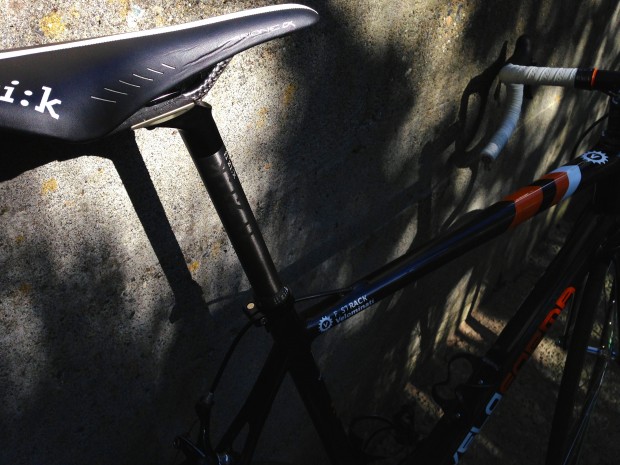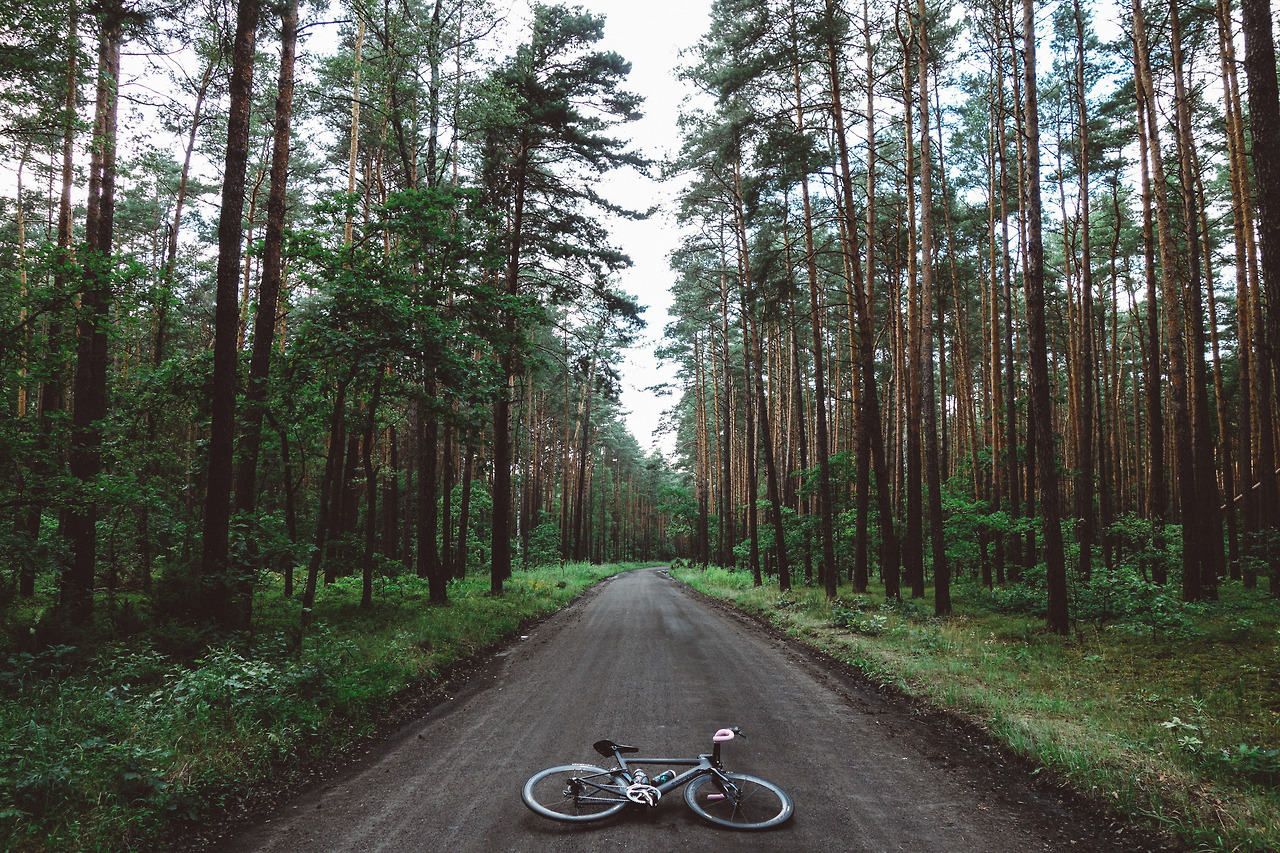The Curse of Four Millimeters

I don’t know how a guy who shows off the better part of a half meter of seat post comes to the conclusion that his saddle is too low, but that precise thought occupies an enormous amount of time. Ever closer looms the minimum insertion point on my seat pin, yet I am irrevocably bound to explore its limits.
I actually wish my legs were shorter; long legs are only useful for the anorexic models who distort our youth’s self-image and for skipping steps on staircases. At the same time, I’ve spent the majority of my life wondering if my seat post was slipping; has my saddle always felt this low? In previous years, I have known better; the question will claw its way into my mind, usually when I’m struggling on a climb, and I will look at the strip of tape I’ve stuck around my seat pin just above the clamp and note that it has not curled up due to the pin sliding through. The saddle is at the right height.
These days, I’m riding a fizik seat post and fizik seat posts come with this cool little sleeve to mark the height. It works perfectly, apart from the fact that it doesn’t curl up like the lowly electrical tape does; were the seat pin to slide, the sleeve would simply side with it. Which means I have to judge the distance between height demarcations on the post to decide if it’s slipped or not. It used to be higher; I’m climbing this badly because the saddle slipped down a bit.
These are easy lies we tell ourselves; that the lack of performance is borne of a problem in our setup – our position or our equipment. Merckx was famously obsessive about seat height, why shouldn’t I be? I just make a casually deliberate stop at the roadside, swiftly raise the saddle a bit, and stage a Cyclocross Remount – the only way a Cyclist should ever board their bicycle once the ride has begun.
But then I got better at judging the marks on the fizik post, and was sure it wasn’t sliding. But still my power was waning and surely it wasn’t my form because I’ve been riding like a thing that’s been riding a lot. Perhaps my position on the bike is evolving, perhaps I should reconsider my stem length and slide my saddle forward to get more over the bottom bracket. Except that I’ve ridden happily in roughly this position for years – and in roughly the same form.
Then came the rains; they had been lacking this Spring, almost to a fault. It had been several weeks or even a few months since I’d been astride my Nine Bike. I set off, and was struck instantly by how comfortable I was, how fluidly the pedals were spinning, and how easily I gobbled up the climbs. Was I peaking today instead of in the usual Two Months, or was there something more sinister going on? There was no question of longer stems and saddles sliding forward; I had the usual sensation that I was in my element, that I was born to be in this position on two wheels and that walking was a locomotion I was leaving behind in my short-lived evolution as a human being.
Knowing the geometries of the two bikes – #1 and The Nine Bike – are virtually identical, I decided to revisit the measurements on #1. I measured the Nine and checked them against #1; the only difference was that the saddle on the #1 had crept up a whopping 4mm. Four millimeters over a saddle height of of 830. I climbed aboard her and set off, amazed at how good she felt. Immediately the power was back, the inherent comfort of riding a bike returned.
All over a lousy 4mm.
Fellow Velominati: we are all students of La Vie Velominatus. We must look to the future and seek to evolve; to experiment with new positions, new techniques, and with new technology. But we must also look to the past and recognize what worked well, when did change affect how well we ride our bikes or how much we loved it? To recognize the boundary between the evolution within us as athletes and to adapt to what feels good over time and those that erode our capacity as riders can be difficult. Sometimes we need a Sensei to help us recognize the difference, other times it will come to us through solitary meditation.
Embrace change, but also keep it at a distance. We should always be ready to return to the past and rediscover what worked before and apply it to the chance we face in the future. Vive la Vie Velomiantus.


@Mike_P
Ha – though apparently it is surprisingly common amongst athletes and is just one of those things that can happen.
@Labann Weld, I thought that was rust from mismaintainance
@Fausto Crapiz Or riding in the rain… seems I ride so much half the time I get soaked and hardly notice.
Somebody say “saddle”? Not giving up my Brooks. Even when the adjuster post snapped, bought one from factory and installed at LBS. But you’re supposed to carry you carcass with your thighs, not your butt. Funny, never stand anymore except on the steepest of hills.
Linked this site in latest blog entry at…
http://bike-n-chain.blogspot.com
My new #1 is a larger bike than my old #1… It’s also got longer cranks. The first time I was out on the new #2 after riding the new #1 for a while, the saddle felt far too short. I raised the thing up a full CM before it felt right… but then it started feeling wrong. Lowered 5mm and everything seemed right with the world again. Still not sure what to think of the difference in crank-arm lengths though.
Tape on your seat post?!
I’m sorry, Frank, that’s amateur hour and should be forbidden per Rule #29. I hereby propose an amendment to said rule – no man-satchels and no carved notches or tape rings on your seat post.
I’ll also submit Rule #96 – Know your measurements. One should commit to memory their correct saddle height ( in mm, measured from centre of spindle to top of saddle at the centre of the saddle clamp), the distance from centre of said saddle clamp to the centre of the handlebars (also in mm) in case the opportunity arises to ride a unique or rare machine. Further, the Rouleur should always have a soft (tailor’s) tape in their gear bag to check these critical dimensions before any epic ride.
And, if your post continues to slip, get some Carbon Paste from Vision or another manufacturer to stop that right now. But, no tape rings!
@Durishin
Specifically: Discern accurate measurements from No.1 — write it down.
@Xyverz
I ride 177.5mm cranks throughout; the other curse unspoken here is getting your fit right across bikes. For me at least, I’ll spend most of the ride adjusting to a new position before I’m happy riding in it, and then the ride is over and I’m back on another bike. If the position is identical, you can get right to loving the different feel of the bike itself.
@Durishin
I reject this on the basis that its idiotic. Not so much for slippage although it happens, but moreso for removing and re-inserting seat posts. When I drive with my bike, I usually have it on a fork mount in the car and the saddle comes off because I’m half ape and half horse. The strip of tape makes it easy to put it back in its right place, same thing with bike cases, which are used much more than I’d like to believe.
Have a look through the bikes in the pro bunch – they all have tape around the pin because they get pulled out so much. Interesting sidenote; pros generally have a stable of bikes around in their most common residences but will travel with their favorite saddle and post and pop it in to keep their backsides happy.
All these things I agree with wholeheartedly (the tailors tape is a classic, I have them all over the house, and in both permanent and travelling tool kits) apart from the various ways you can make it more precise, based on the assumptions:
This allows you to measure more precisely the distances – with the same saddle you can use the center of the saddle rails for crank height, which means there’s less error in how high or low your head is relative to the “center of the saddle” which can amount to a few centimeters easily. Add or subtract for crank length difference and stack/spindle height.
Also, using the same saddle means you can use the tip of the saddle, not the center to measure BB setback (a measurement you missed in your list) and saddle-bar distance.
Another measurement you missed is saddle to bar drop. Also bar reach and bar depth are two measurements to be aware of, at least. I ride the same bars on all bikes to remove any doubt because all bars are off from the others by at least a few mils.
@frank
The fifth bullet. For symmetry. Genius.
@frank
You’ve almost out-Strack’d yourself. That’s gold right there.
@frank
Agreed on all this. I have the same saddle on all my road bikes and have a couple spare in case they stop making them. I do the same with bars as far as I can. My #2 felt odd despite the saddle to BB/tip of saddle to center of stem/Saddle setback from BB being the same. Bar width was the same. What was different was the drop and reach of the bars. Replaced them with bars as close to the others as possible and I’m a much happier camper.
This article has also made me recheck all measurements compared to #1. I thought they were the same, but just a few mms off in a couple of cases. Changes made and one more thing to worry about eliminated. .
Apologies if I’m repeating anything, but bike fitter Steve Hogg talks about a DIY of finding a hill that takes a few minutes to ride, warming up, then riding under load to see whether you feel like you are on a stair stepper or not. You then either raise or lower your saddle in 3mm increments until you get to a sweet spot. He then says to drop it 3 more mm, because “not every day is a good day on the bike.
@frank I don’t disagree, though the conversation is about saddle height, not the rest and, obviously, your insertion of “basic” in my proposed prose for Rule #96 would have saved the now wasted electrons.
I’ve a friend who is a chief mechanic for one of those Pro Tour team thingies. I’ve queried him as to the prevalence of taped posts. I will report his response.
So, good on you for the tape, then (its colorway matches your saddle and top tube, I will assume) – though it does lose its accuracy when the post slides. Try the carbon paste.
Continued good luck.
Cheers!
boy name that means protector
coffee with cream and sugar
cups to grams conversion
When my steel tourer/everyday/wet-weather bike was new, it had a real problem with a slipping seat post. Never mind 4mm, this was slipping down about 4 inches every time I rode it. However hard I tightened the seat bolt, it made no difference. I completely chewed up two alloy seatpins before I discovered the allen bolt was too long. It didn’t matter how much it was tightened, it didn’t pull the seat tube together around the seatpin. Doh!